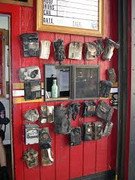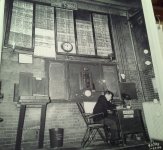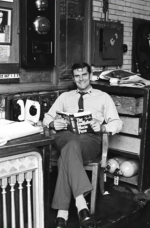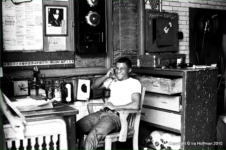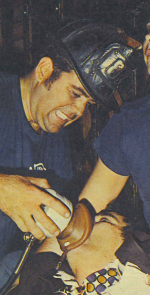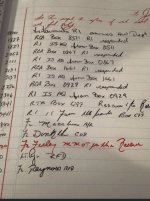They were renovated the same time as Red Hook 1975-76. There were a few of those Firehouses around with two HW , two Kitchens but one heating plant. I believe they were built that way to be able to make two separate companies with two sets of Officers. I’m sure the FDNY historians out there can explain it better.t123ken,
I know 280 and 132 had separate housewatches when the house was built and up until the 70's. I don't know exactly when it became a combined housewatch area.
You are using an out of date browser. It may not display this or other websites correctly.
You should upgrade or use an alternative browser.
You should upgrade or use an alternative browser.
Housewatch areas
- Thread starter Capttomo
- Start date
- Joined
- Apr 23, 2018
- Messages
- 1,172
- Joined
- Apr 23, 2018
- Messages
- 1,172
The 2 above pictures are from Watkins St. with the buff answering the phone. A/C is what made everybody enclose the HW area. The Tin House in Bklyn. had 3 enclosed sides and when we went A/C we used a heavy plastic drape, identical to a butchers door to keep the cool air in.
- Joined
- Apr 23, 2018
- Messages
- 1,172
HOUSEWATCH
Every firehouse in NYC has a housewatch (HW). If the kitchen is the soul of the firehouse it is safe to say that the housewatch is the heartbeat. Inside the housewatch the daily activity is recorded in a journal, telephone calls received, visitors and chiefs welcomed and alarms dispatched. The HW is where the group chart is displayed, the department radio monitored and department orders maintained.
In pre-war firehouses, the HW area was a small space in the front of the firehouse on the apparatus floor that was designed to receive alarms and monitor the telegraph system. The houswatchman would record incoming bells on a large chalkboard and turnout the company when required. Usually the area was opened and exposed to heat during the summer and cold during the winter, a small desk with a straight back wooden chair was placed on a slab of concrete a step up from the apparatus floor, the area surrounded with brass railings and poles. The firefighter on HW duty wore a dress uniform shirt with tie and a bell cap, mounted nearby was his name plate with rank affixed to the side of the HW somewhere viewable to visitors.
Since the days of the horses, with the assistance of members' handi-work these small HW areas started to transform into small rooms with walls, windows, a ceiling and climate control. With the apparatus floor hot during the summer and cold during the winter, doors were added to make it comfortable for the three hours shifts. Future HW’s became more elaborate with creative brick work, cedar shakes, texture plywood and incorporated pocket doors. Newer firehouses built after the late 70’s were designed with a larger HW that resembled an office with spacious surroundings like Ladder 5 and Ladder 15’s quarters.
VERBOTEN! Early days TV’s were not permitted at one point. In many older HW’s throughout the city you could still find a small “cabinet” over the desk with a hinged cover that could contain a small portable TV inside and if a Chief arrived for roll call or unexpectedly the front cover would quickly close hiding that dastardly distraction.
Years ago a bench was strictly forbidden inside the HW, you were not permitted to have a couch or anything that could be construed as a bed in the HW lest being caught in the horizontal position. But the cleverness of some firehouse craftsmen a bench seat was constructed to accommodate other members who wanted to join you at the HW. For many years certain Chiefs would not approve of these additions, but slowly members added slick subtle changes to be a little more comfortable during the long early morning HW shift. For instance In addition to bench seats that “doubled” as a you-know what, In E 88 we had a “study table” that was hinged onto the back wall of the HW and could be “lowered”, supported by chains from the leading edge anchored to the wall and when lowered it became a bunk, er, I mean desktop.
Speaking of ENGINE 88 / LADDER 38: Originally the firehouse was designed with two separate HW’s, as were many other firehouses throughout the city. The two HW’s mirrored on the inside wall that separated the two companies. At one point in time, the members breached a small hole between the two housewatches so as to be able to speak to the firefighter on the other side and have some company during the lonely late watch. Finally, the members saw the light and blasted through the wall combining the two HW’s into one.
INSIDE THE HW: Inside the HW is a group chart board, desk panel, HW journal, dispatch computer, telephones, a binder of department orders and an index box filled with route cards.
GROUP CHART BOARD: Inside the HW of every firehouse in the city you will find a “group chart board”, or some places have a “wheel”. They may not all be alike, yet their functions are the same. The chart is adjusted daily to the incoming groups scheduled to report for duty and dictates HW assignment and details fairly.
HOUSE WATCH ASSIGNMENTS: HW duties are alternated monthly by each company, each company takes a shot at covering the HW for the month. Usually the company that has HW duties does not have the responsibility of procuring the meal. A FF is assigned HW for three hours according to the rotating group chart to be fair. The day tour is covered by the first three incoming firefighters according to the group chart, the first watch is 9x12, the second 12x3, etc. The night tour has five HW assignments, the firefighter that has the first 6x9 HW also has to recycle and catch the 6x9 morning HW too! Firefighters are not permitted to leave the HW unattended, if necessary for any reason, another FF stands by until the other firefighter returns.
In addition to answering phones, turning out the company the HW FF makes sure the front of quarters is clear of any obstacle that may hinder response.
DESK PANEL: On the HW desk panel is the department phone, a set of colored push buttons to open the bay door, push button for bells, a red phone from the Boro CO and the department radio. In the middle of the desk is the HW journal.
HW JOURNAL: All daily activity of the company is recorded line by line in the 500 page journal. Each page is numbered, no pages are ever ripped out and no line is skipped recording entries. Runs, fuel deliveries, complaints, significant events are recorded by the firefighter on HW. The journals are kept for twenty years. Each Company officer makes his entry at 0900 and 1800 hrs depicting the manpower assignment.
When the assigned member begins his day tour 0900-1200 HW duties, which is commonly called the “9 by” immediately after the officer enters his “roll call” for the day tour the HW FF enters his name in the HW journal in blue or black ink. Only the HW FF writes in blue or black ink, anyone else that makes an entry, whether it be another officer, visiting chief or fire prevention employee signing out, are required to use red ink only. With that, great minds came up with the idea of taping a red pen to a blue pen with points facing opposite. The pen is left in the fold of the journal.
The 9 by HW FF enters the next line directly below the officers signed roll call; “Firefighter Gage, E88, relieved FF DeSoto E88 on HW. Department PAQ (property, apparatus, quarters) in good condition”. After those entries are completed, company runs and all other incidents mentioned previously are recorded by the HW FF.
THE COMPUTER: During the “Glory Days”, the dispatch computer was not a touchscreen then, nor did the computer “voice” announce what company had to respond. You had to read the ticket, acknowledge the run in three steps by first pressing the corresponding company button, second by pressing the 10-4 button, and finally the “send” button to acknowledge the run.
When an alarm came in, the following sequence was done in double time; Announce the run, either by public address system or in a loud voice, “GET OUT 82/31, FIRST DUE, PHONE ALARM”, tap-out the required number of in-house bells, open bay door, rip off the double rolled carbon print out and hand a copy to the company officer, then hustle and quickly gear up.
If you were on HW and someone banged on the door to report a fire or emergency, this was called a “Verbal”. In this instance you simply turned out the company by hitting the bells and announcing over the public address system the “Verbal”. On the HW computer you'd press the company number, followed by pressing the “verbal” button on the computer, then “send” button. As the apparatus rolled out of quarters, the CO would contact the officer to ascertain information about the verbal and assign a box number, this process alleviated delay and actualized a quicker response.
TELEPHONES: There were three types of phones in the HW. The Department telephone that was for business. Some of the department phones were either attached to the HW panel or free standing on the desktop. When a call came in on the department phone, you immediately picked up and stated; “E 24 / L 5 Fireman Gage”.
Another phone that had no dial or numbers, just a small red light was the red phone mounted on the panel that was connected directly to the boro CO. It was like an intercom that you could speak directly with the CO. An earlier version years ago was a regular red phone, if the dispatcher sensed from incoming calls that you were headed to a job, you received “three rings” in rapid succession, and the dispatcher would tip you off as another dispatcher typed out the info to be sent to the HW computer.
The third phone was the outside “pay” phone where you answered the incoming personal calls for a member. This phone was a coin operated phone mounted somewhere in the firehouse with an extension line directly to the HW where you could only receive the call then announce the party's name. It seemed like every firehouse always had one member who had way too many incoming calls and that was annoying, sometimes the phone simply fell off the hook.
CHIEF VISITS: When visiting Chiefs arrive at quarters the HW FF promptly announces “CHIEF IN QUARTERS” and greets the chief from the HW desk with a hand salute. By this time, the Company Officer will come to the HW and greet the Chief. The Chief records his visit in the rear section of the journal designated for “Chief Visits”. On occasion, the Chief will ask for a Company roll call. In this instance the HW FF will announce a roll call over the intercom system and the on duty members will assemble and form ranks in front of the apparatus. The company officer has a set procedure for roll call as per department guidelines. Usually the chief will speak to the group at this time if he has something to say, if not, the formality concludes and the HW FF returns to the HW.
ROUTE CARDS: Inside the HW was a tin index card holder with flip top cover. Whenever a company is “relocated” to another company quarters, the response area could be unfamiliar to the covering crew. To alleviate the confusion, either the Officer or chauffeur would locate the tin box in the HW. When the company receives an alarm, you’d simply refer to the index card with corresponding box number. The index card gave you directions to the box.
DOING HOUSEWATCH: I enjoyed doing HW, in fact I usually spent most of my time in the HW at L 5 during the months when we were designated. The HW office was very comfortable with a large glass window looking outside onto Sixth Avenue, the HW did not have that confined feeling and it was usually quiet. I’d settle in during the day tour, fresh cup of hot Joe and the NY Post. As a Ladder Chauffeur I liked monitoring the department radio and being aware of incidents around us. The quiet time afforded me time to study for the Lieutenants exam, especially during the night tour, the early morning peacefulness and tranquility was very conducive to studying. I’d take the watch from midnight all the way through till morning. Around 4 am I’d fix myself a nice fresh pot of coffee, open my study books and absorb the material for the next few hours. Around 0600 it was time to flip on the FM radio to WCBS 101 oldies and listen to “Harry Harrison, the Morning Mayor” and catch the sunrise.
There is a tale about a young firefighter covering one of his first early morning HW details:
The house is very still, apparatus floor lights are turned off and all is quiet except for the occasional creak and groan of the resting fire apparatus as the rig settles. Later that morning the lad mentions to the senior firefighter about his HW ordeal and the sounds from the apparatus. The senior firefighter says; The sounds he heard were made by Brothers who had worked in the firehouse years and years ago that are now gone but every now and then return for a moment to sit on the old rig one more time.
Group Chart Riding Position Chalkboard.
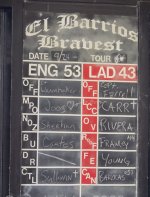
Every firehouse in NYC has a housewatch (HW). If the kitchen is the soul of the firehouse it is safe to say that the housewatch is the heartbeat. Inside the housewatch the daily activity is recorded in a journal, telephone calls received, visitors and chiefs welcomed and alarms dispatched. The HW is where the group chart is displayed, the department radio monitored and department orders maintained.
In pre-war firehouses, the HW area was a small space in the front of the firehouse on the apparatus floor that was designed to receive alarms and monitor the telegraph system. The houswatchman would record incoming bells on a large chalkboard and turnout the company when required. Usually the area was opened and exposed to heat during the summer and cold during the winter, a small desk with a straight back wooden chair was placed on a slab of concrete a step up from the apparatus floor, the area surrounded with brass railings and poles. The firefighter on HW duty wore a dress uniform shirt with tie and a bell cap, mounted nearby was his name plate with rank affixed to the side of the HW somewhere viewable to visitors.
Since the days of the horses, with the assistance of members' handi-work these small HW areas started to transform into small rooms with walls, windows, a ceiling and climate control. With the apparatus floor hot during the summer and cold during the winter, doors were added to make it comfortable for the three hours shifts. Future HW’s became more elaborate with creative brick work, cedar shakes, texture plywood and incorporated pocket doors. Newer firehouses built after the late 70’s were designed with a larger HW that resembled an office with spacious surroundings like Ladder 5 and Ladder 15’s quarters.
VERBOTEN! Early days TV’s were not permitted at one point. In many older HW’s throughout the city you could still find a small “cabinet” over the desk with a hinged cover that could contain a small portable TV inside and if a Chief arrived for roll call or unexpectedly the front cover would quickly close hiding that dastardly distraction.
Years ago a bench was strictly forbidden inside the HW, you were not permitted to have a couch or anything that could be construed as a bed in the HW lest being caught in the horizontal position. But the cleverness of some firehouse craftsmen a bench seat was constructed to accommodate other members who wanted to join you at the HW. For many years certain Chiefs would not approve of these additions, but slowly members added slick subtle changes to be a little more comfortable during the long early morning HW shift. For instance In addition to bench seats that “doubled” as a you-know what, In E 88 we had a “study table” that was hinged onto the back wall of the HW and could be “lowered”, supported by chains from the leading edge anchored to the wall and when lowered it became a bunk, er, I mean desktop.
Speaking of ENGINE 88 / LADDER 38: Originally the firehouse was designed with two separate HW’s, as were many other firehouses throughout the city. The two HW’s mirrored on the inside wall that separated the two companies. At one point in time, the members breached a small hole between the two housewatches so as to be able to speak to the firefighter on the other side and have some company during the lonely late watch. Finally, the members saw the light and blasted through the wall combining the two HW’s into one.
INSIDE THE HW: Inside the HW is a group chart board, desk panel, HW journal, dispatch computer, telephones, a binder of department orders and an index box filled with route cards.
GROUP CHART BOARD: Inside the HW of every firehouse in the city you will find a “group chart board”, or some places have a “wheel”. They may not all be alike, yet their functions are the same. The chart is adjusted daily to the incoming groups scheduled to report for duty and dictates HW assignment and details fairly.
HOUSE WATCH ASSIGNMENTS: HW duties are alternated monthly by each company, each company takes a shot at covering the HW for the month. Usually the company that has HW duties does not have the responsibility of procuring the meal. A FF is assigned HW for three hours according to the rotating group chart to be fair. The day tour is covered by the first three incoming firefighters according to the group chart, the first watch is 9x12, the second 12x3, etc. The night tour has five HW assignments, the firefighter that has the first 6x9 HW also has to recycle and catch the 6x9 morning HW too! Firefighters are not permitted to leave the HW unattended, if necessary for any reason, another FF stands by until the other firefighter returns.
In addition to answering phones, turning out the company the HW FF makes sure the front of quarters is clear of any obstacle that may hinder response.
DESK PANEL: On the HW desk panel is the department phone, a set of colored push buttons to open the bay door, push button for bells, a red phone from the Boro CO and the department radio. In the middle of the desk is the HW journal.
HW JOURNAL: All daily activity of the company is recorded line by line in the 500 page journal. Each page is numbered, no pages are ever ripped out and no line is skipped recording entries. Runs, fuel deliveries, complaints, significant events are recorded by the firefighter on HW. The journals are kept for twenty years. Each Company officer makes his entry at 0900 and 1800 hrs depicting the manpower assignment.
When the assigned member begins his day tour 0900-1200 HW duties, which is commonly called the “9 by” immediately after the officer enters his “roll call” for the day tour the HW FF enters his name in the HW journal in blue or black ink. Only the HW FF writes in blue or black ink, anyone else that makes an entry, whether it be another officer, visiting chief or fire prevention employee signing out, are required to use red ink only. With that, great minds came up with the idea of taping a red pen to a blue pen with points facing opposite. The pen is left in the fold of the journal.
The 9 by HW FF enters the next line directly below the officers signed roll call; “Firefighter Gage, E88, relieved FF DeSoto E88 on HW. Department PAQ (property, apparatus, quarters) in good condition”. After those entries are completed, company runs and all other incidents mentioned previously are recorded by the HW FF.
THE COMPUTER: During the “Glory Days”, the dispatch computer was not a touchscreen then, nor did the computer “voice” announce what company had to respond. You had to read the ticket, acknowledge the run in three steps by first pressing the corresponding company button, second by pressing the 10-4 button, and finally the “send” button to acknowledge the run.
When an alarm came in, the following sequence was done in double time; Announce the run, either by public address system or in a loud voice, “GET OUT 82/31, FIRST DUE, PHONE ALARM”, tap-out the required number of in-house bells, open bay door, rip off the double rolled carbon print out and hand a copy to the company officer, then hustle and quickly gear up.
If you were on HW and someone banged on the door to report a fire or emergency, this was called a “Verbal”. In this instance you simply turned out the company by hitting the bells and announcing over the public address system the “Verbal”. On the HW computer you'd press the company number, followed by pressing the “verbal” button on the computer, then “send” button. As the apparatus rolled out of quarters, the CO would contact the officer to ascertain information about the verbal and assign a box number, this process alleviated delay and actualized a quicker response.
TELEPHONES: There were three types of phones in the HW. The Department telephone that was for business. Some of the department phones were either attached to the HW panel or free standing on the desktop. When a call came in on the department phone, you immediately picked up and stated; “E 24 / L 5 Fireman Gage”.
Another phone that had no dial or numbers, just a small red light was the red phone mounted on the panel that was connected directly to the boro CO. It was like an intercom that you could speak directly with the CO. An earlier version years ago was a regular red phone, if the dispatcher sensed from incoming calls that you were headed to a job, you received “three rings” in rapid succession, and the dispatcher would tip you off as another dispatcher typed out the info to be sent to the HW computer.
The third phone was the outside “pay” phone where you answered the incoming personal calls for a member. This phone was a coin operated phone mounted somewhere in the firehouse with an extension line directly to the HW where you could only receive the call then announce the party's name. It seemed like every firehouse always had one member who had way too many incoming calls and that was annoying, sometimes the phone simply fell off the hook.
CHIEF VISITS: When visiting Chiefs arrive at quarters the HW FF promptly announces “CHIEF IN QUARTERS” and greets the chief from the HW desk with a hand salute. By this time, the Company Officer will come to the HW and greet the Chief. The Chief records his visit in the rear section of the journal designated for “Chief Visits”. On occasion, the Chief will ask for a Company roll call. In this instance the HW FF will announce a roll call over the intercom system and the on duty members will assemble and form ranks in front of the apparatus. The company officer has a set procedure for roll call as per department guidelines. Usually the chief will speak to the group at this time if he has something to say, if not, the formality concludes and the HW FF returns to the HW.
ROUTE CARDS: Inside the HW was a tin index card holder with flip top cover. Whenever a company is “relocated” to another company quarters, the response area could be unfamiliar to the covering crew. To alleviate the confusion, either the Officer or chauffeur would locate the tin box in the HW. When the company receives an alarm, you’d simply refer to the index card with corresponding box number. The index card gave you directions to the box.
DOING HOUSEWATCH: I enjoyed doing HW, in fact I usually spent most of my time in the HW at L 5 during the months when we were designated. The HW office was very comfortable with a large glass window looking outside onto Sixth Avenue, the HW did not have that confined feeling and it was usually quiet. I’d settle in during the day tour, fresh cup of hot Joe and the NY Post. As a Ladder Chauffeur I liked monitoring the department radio and being aware of incidents around us. The quiet time afforded me time to study for the Lieutenants exam, especially during the night tour, the early morning peacefulness and tranquility was very conducive to studying. I’d take the watch from midnight all the way through till morning. Around 4 am I’d fix myself a nice fresh pot of coffee, open my study books and absorb the material for the next few hours. Around 0600 it was time to flip on the FM radio to WCBS 101 oldies and listen to “Harry Harrison, the Morning Mayor” and catch the sunrise.
There is a tale about a young firefighter covering one of his first early morning HW details:
The house is very still, apparatus floor lights are turned off and all is quiet except for the occasional creak and groan of the resting fire apparatus as the rig settles. Later that morning the lad mentions to the senior firefighter about his HW ordeal and the sounds from the apparatus. The senior firefighter says; The sounds he heard were made by Brothers who had worked in the firehouse years and years ago that are now gone but every now and then return for a moment to sit on the old rig one more time.
Group Chart Riding Position Chalkboard.

Last edited:
Bernie Cassidy B16, great chief, even nicer guyCould that be future BC B. Cassidy in the E 82 watch?
- Joined
- Dec 14, 2012
- Messages
- 448
214/111 from what I remember, cant shut the lights off and half to walk through housewatch when entering firehouse.
7/1 has an interesting watch setup
7/1 has an interesting watch setup
To put things in perspective today, I have the watch chart in the wheel configuration from the Tin House and offered to the new house and was told they don't use one anymore. It seems everything is done electronically today? You mean I got the 3x6 tonight again.
- Joined
- Nov 2, 2020
- Messages
- 1,290
Did anyone mention the HW having to go down to the cellar and throw coal on the furnace fire during the night tour on the 12 by or 3 by watch?
- Joined
- May 6, 2010
- Messages
- 17,415
In 108 on Seigel St we had 2 coal furnaces....a big one (w/big coal) for FH heat in cold weather & a smaller one (w/pea coal) for hot water ....the hot water one had to be tended all year round.....worst thing was if a relocater failed to maintain the heat furnace going properly (or let it go out ).Did anyone mention the HW having to go down to the cellar and throw coal on the furnace fire during the night tour on the 12 by or 3 by watch?
Thanks JohnnyGage for detailed summary and all other contributors. Some additional housewatch questions that come up:
- What were the 2 housewatch firehouses?
- Were there ever any 3 housewatch firehouses?
- How is housewatch handled by Marine companies?
- How do Rescues, Squads and special units handle housewatch?
- Who covers housewatch when company with housewatch responds?
- Does chief's aide cover housewatch when chief is the only unit in quarters?
- Was there ever a housewatch located in firehouse location which was not in front of apparatus floor?
- Was the NY Fire Patrol housewatch similar?
- What were the 2 housewatch firehouses?
- Were there ever any 3 housewatch firehouses?
- How is housewatch handled by Marine companies?
- How do Rescues, Squads and special units handle housewatch?
- Who covers housewatch when company with housewatch responds?
- Does chief's aide cover housewatch when chief is the only unit in quarters?
- Was there ever a housewatch located in firehouse location which was not in front of apparatus floor?
- Was the NY Fire Patrol housewatch similar?
- Joined
- Apr 25, 2008
- Messages
- 720
Outstanding questions for an outstanding discussion!
There was one house that had 2 desks on the apparatus floor without a wall between them,298 and 299 using one, 275 and 127 using the other.
The Patrol had housewatches but the ma n on house watch in numbers 1 and 3 remained in quarters to record alarms for insurance purpose. Everyone responded in Patrol 2.
The Patrol had housewatches but the ma n on house watch in numbers 1 and 3 remained in quarters to record alarms for insurance purpose. Everyone responded in Patrol 2.
- Joined
- Nov 2, 2020
- Messages
- 1,290
Question 1......The Big House in Jamaica. E275, 298, 299, L127, 50 Bn. had 2 HW.
Question 4...... The same as any other Company.
Question 5...... If a double house and only one company is responding and that company was in watches then the non responding unit takes housewatch.
I think I have a few lol
Question 4...... The same as any other Company.
Question 5...... If a double house and only one company is responding and that company was in watches then the non responding unit takes housewatch.
I think I have a few lol
- Joined
- Sep 7, 2020
- Messages
- 2,584
Some great questions ! Brings a smile to my face to see the interest and furthering of discussion.Thanks JohnnyGage for detailed summary and all other contributors. Some additional housewatch questions that come up:
- What were the 2 housewatch firehouses?
- Were there ever any 3 housewatch firehouses?
- How is housewatch handled by Marine companies?
- How do Rescues, Squads and special units handle housewatch?
- Who covers housewatch when company with housewatch responds?
- Does chief's aide cover housewatch when chief is the only unit in quarters?
- Was there ever a housewatch located in firehouse location which was not in front of apparatus floor?
- Was the NY Fire Patrol housewatch similar?

